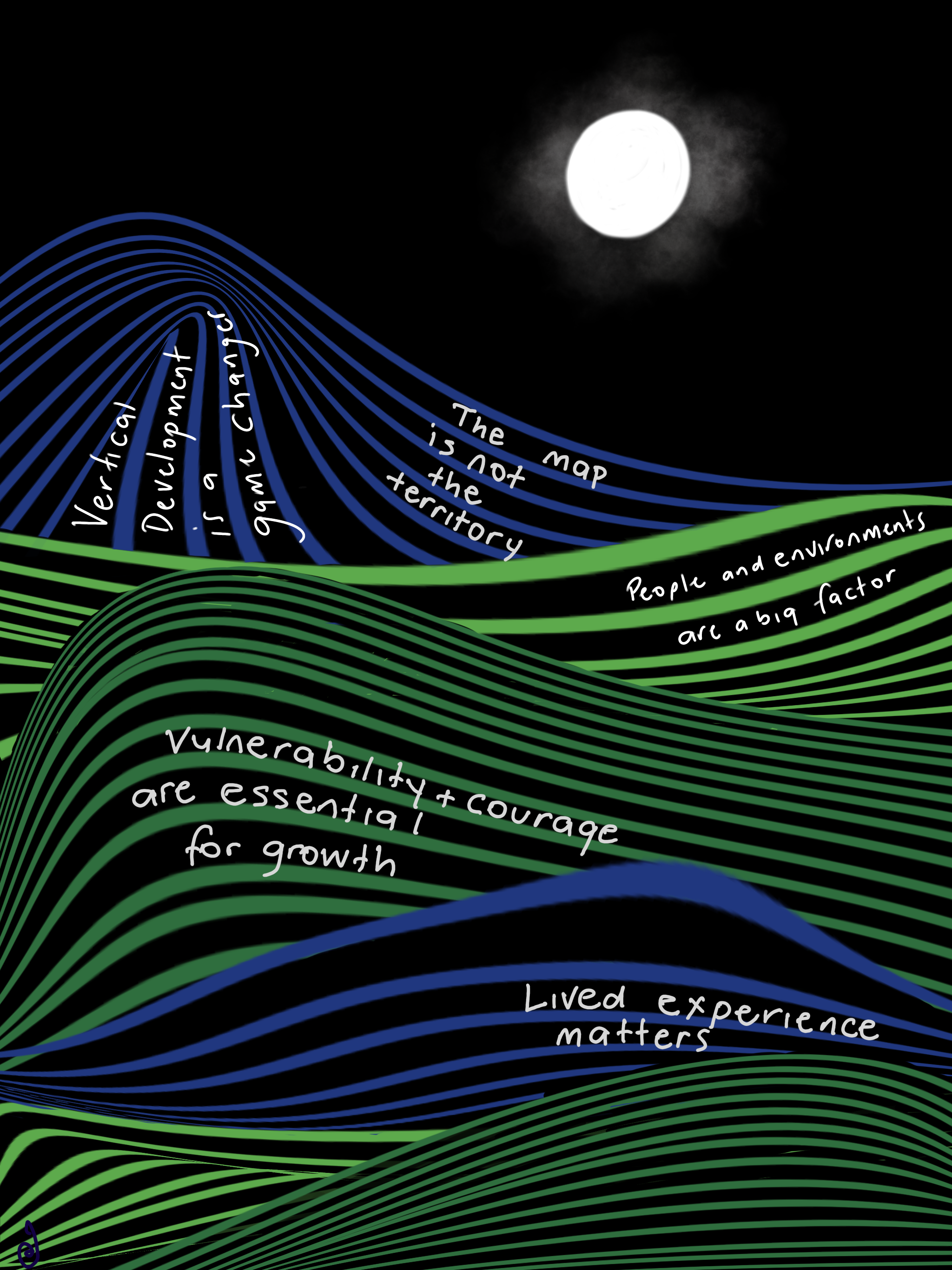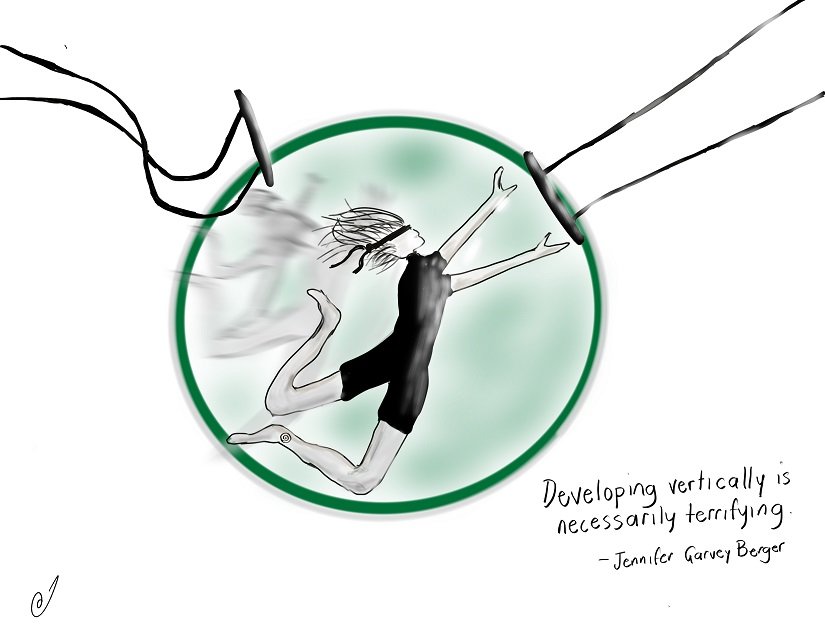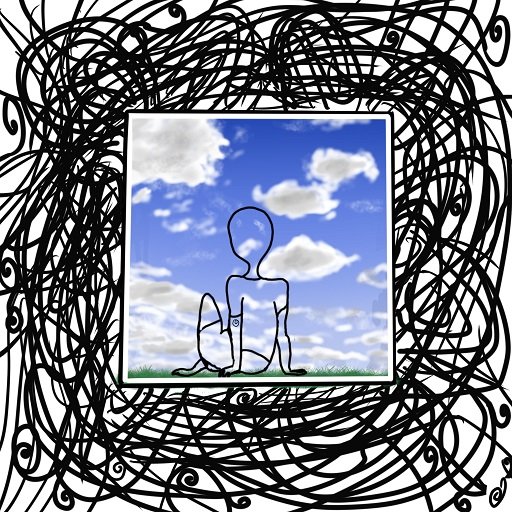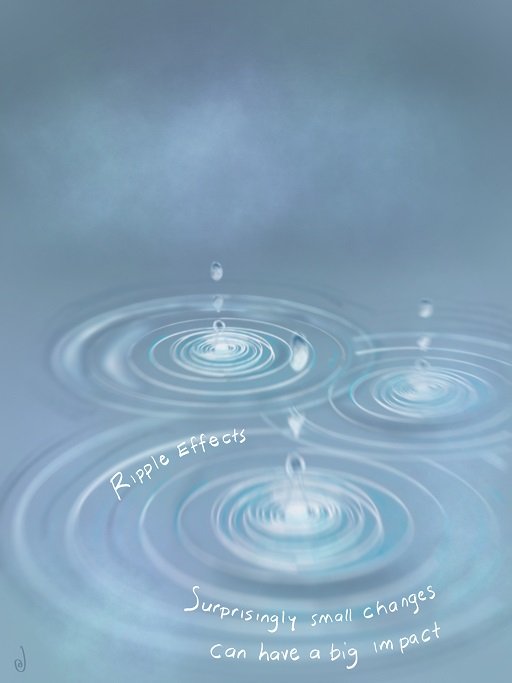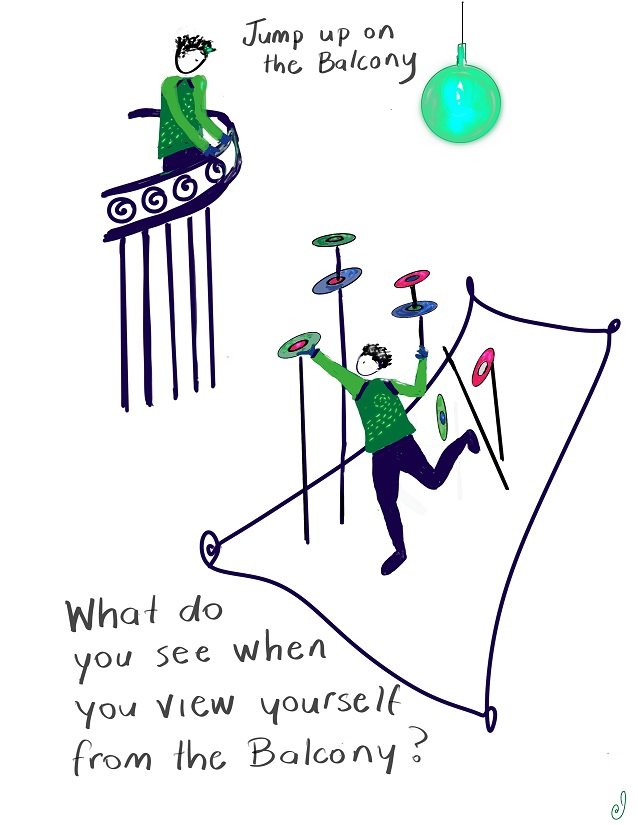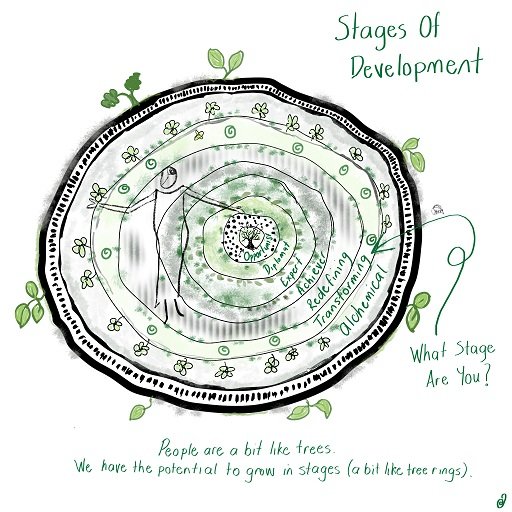Introducing our new Illustration series
And the Vertical Development journey behind them.
Words by Joanne Ostler
A few months ago I was out walking and listening to a podcaster who mentioned her habit of doodling. I immediately felt a deep sense of yearning along the lines of “I would love to be able to draw my ideas.” This is not the first time I’ve had that thought. As a child, I occasionally fantasised about drawing and illustrating children's books, but I never told a soul. In fact, I suspect I hardly even told myself. This was the first time I seriously thought I could just try.
When it comes to anything artistic, I have always believed there were three types of people: those who had natural talent; those who could learn to draw well; and those with zero talent – like me.
I now realise I have collected many stories as “evidence” that has fed into that belief over the years. For example, when my son just started school, his teacher shared with me that his drawings were very odd. I asked to see an example, and I realised he drew his ‘people’ a lot like I did!
Stepping back for a moment, (jumping up on the balcony), I find it incredible how big a block some of our beliefs and assumptions (hidden and visible) are in our lives and how they guide our choices and our experiences. (If you are curious about what some of your big hidden beliefs and assumptions might be, I think you’d appreciate the Immunity To Change concept, or here, if you prefer to listen to a podcast).
I am now on a personal journey to discover my passion for illustration which I’d like to share with you from a vertical development perspective. (Note that throughout this blog, I’ll highlight key concepts in bold).
My recent decision to “just try” felt uncomfortable. I’m a developmental coach but I’m also human. My clients, after our meetings, often comment on feeling better, braver, and more intentional. They say they feel like they could be anyone! And yet, when left to my own circular thoughts, I constrain myself. But listening to that podcast on that particular day, I caught myself. I saw with more clarity, my self-defeating unconscious thoughts. I questioned my beliefs, my assumptions and my “block”.
And then it got harder. I had started questioning this particular belief/assumption enough to feel very uncomfortable. My inner critic was crying out, “ridiculous. Stupid. Who do you think you are?” And yet at the same time, I also noticed a spark of energy and excitement: “Maybe? What if? Imagine if I could…? What’s the worst case? (Nothing much). What have I got to lose? (Time, proving to myself I can’t draw, ego?).”
I became increasingly clear and resolute that I really wanted to illustrate concepts that would spark interest and understanding about vertical development, adult development and human potential.
In adult development terms, I was reflecting honestly and I was experiencing a challenge, and discomfort. Because I was also outside walking at the time, my mind had the space to reflect, be more relaxed and present, and it gave me perhaps more opportunities for getting on the balcony myself. In doing so I could bring curiosity, and face a little more bravely into deeper lines of self-inquiry. I could hold the question “what if I could…” a little longer with courage, patience and self-compassion.
I know enough about how the brain works to know this is how insight and creativity happens, and that it’s super useful to be able to grab those moments and do something with them before the sparks fade.
So, when I got home I rang my daughter, who happens to be a talented visual designer and communicator. On the phone, I sheepishly shared what I was thinking, and to my relief she was supportive and encouraging. “Go, mum! I think that’s great. Why not give it a try?” It was so motivating! I remember sharing with her that I wanted to illustrate concepts like “taking a balcony view” and how frustrating I found it to not be able to draw what was in my head. I remember asking, vulnerably, but also knowing I could completely trust her with my heart and mind, “am I silly to be doing this? Can I hope to get good enough?”
This phone call was very significant for me. She continued to call and ask me about my drawings and my learning process on a regular basis, and to prompt me and challenge my thinking.
In developmental terms, this is about support (and challenge and reflection). Awareness is one thing, but it is often not enough on its own. Where is our support? What’s the nature of that support? How do we experience that support?
It’s also about discomfort and courage. A willingness to stay in the discomfort somehow. Too early, we often tap out. It’s too hard, we avoid, we fight, we defend, we seek echo chambers. This is where having high quality support is crucial. A shoulder to cry on or a friend to download might be good but insufficient for real growth to happen. Also important is having tools and frameworks to guide our minds, our attention and our intentions.
As I embarked on “Day One of my Illustrating Journeying”, I jumped online and scouted YouTube for tutorials. This process took a while as many teachers were just not a good match for me (a bit like how you need to find a coach/consultant/educator who resonates with you).
But, then I stumbled on Brendon Schaefer and his Episode one, Learn to Draw, on YouTube.. This video was wonderful. I could not believe that I could draw a sphere. Man, I was so amazed with that sphere! A few of Brendon’s early concepts really hit home with me.
Learning to see. I realised I could “learn to see” anew, or in other words seeking other or diverse perspectives. I started looking at everything, intrigued. The shape of faces - what makes one face different from another? I started drawing trees, hills, my hands, flowers, family baby photos etc and noticing the patterns.
Finding the shape. How I loved this one! We don’t just draw the circle in one go. The shape of the circle emerges, through the process of light pencil strokes, until you’re ready to choose the shape and sharpen up the line. Then the lighter and earlier lines almost disappear. It’s similar to a great coaching conversation. It could also relate to observing systems, change, patterns, turbulence, development. Things emerge… if we’re intentionally paying attention.
Values and light sources. A flat object suddenly has dimensions and depth. Isn’t that delightful in terms of art and metaphorically for humans?
The tiniest changes in a line, shape or weight etc have a huge impact on the picture. It was astonishing how much a minuscule change affected the visual impact. In vertical development terms, this is known as ripple effects.
From there, I became “addicted”. Obsessed with learning and improving. My intentional attention was very focused! I bought new pens, pencils, and played with different types of paper. But after a while, I realised I was bumping up against another challenge. My aspiration was to illustrate concepts and the paper/pencil thing was great because in order to illustrate, you have to be able to draw at least in a rudimentary way. But I wanted to learn how to draw the ideas in my head and to be able to offer these, digitally. I also was faced with the problem of shaky hands. Not ideal for detailed art.
So I jumped on the balcony again and started thinking about other options. I went to my supporter, my daughter, and asked for ideas. She suggested a few options and I researched a couple of these. I experimented with Illustrator for a while, before tweaking my direction and deciding on investing in an iPad and Procreate software. This has turned into another steep learning curve. Using an iPad screen is completely different to using pencil and paper. But I see so many benefits and I'm persisting.
Then, only a few weeks ago (February 2023), I initiated a conversation with my incredible colleague, Aenslee Tanner, of Spring Leadership, (everyone needs an Aenslee in their life, and I feel incredibly lucky to have THE Aenslee in mine). I shared my desire and drive (intrinsic developmental motivation) to illustrate concepts to spark interest and understanding about the fields of vertical development, adult development and human potential in general.
Aenslee listened, inquired, and supported me to take the next step, which has led me to share my story with you today as a way of introducing myself and my illustration journey story. I’m still very much a beginner, a learner, and one of my next challenges is around navigating the tension (the polarities of both/and not either/or) of building a visual “style” for Spring Leadership and allowing my creative and learning process to build naturally. Perhaps the style will be an evolving or unfolding process? It is perhaps also an example too of the difference between horizontal learning (learning stuff) AND vertical development (a qualitative shift). So, we will see how well I go with this.
I have started creating vertical and adult development illustrations and I’m excited (and nervous) to begin to share these with you, starting soon, on Spring’s LinkedIn feed and website blogs. I really hope you might choose to join us there and engage in some conversations along the way.
Lastly, an invitation for you. Are you or do you want to be on a journey too, not only for yourself but for others around you? Do you want to develop, in a vertical sense? Are you intrigued to discover how you and others might do so and what difference that would make to your life? What’s the impact you’re wanting to make on your world, and to do that, who is the person you want to become next?
The vertical development journey has changed my life. I am staggered that so many people don’t know about this or the potential it offers. Do you? Do you want to join the Spring team on the frontiers of the vertical development field? It’s a huge missing link in human development and leadership programmes.
Signing off with a heartfelt thank you for reading this.
Love from,
Jo
P.S. To help you find some ways to approach the question of your own development journey and possibilities, you might find the “map” of vertical development stages, on pages 16/17 of Spring’s Magazine to be helpful. Perhaps think about where you see yourself in terms of these stages?

